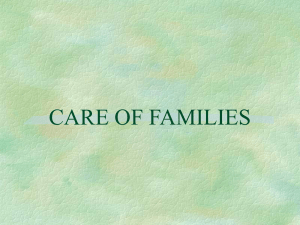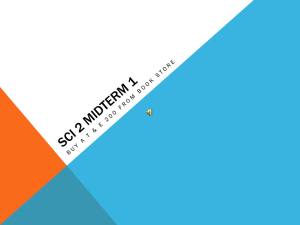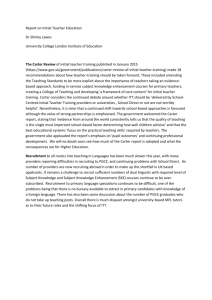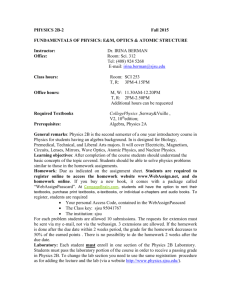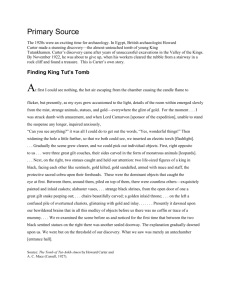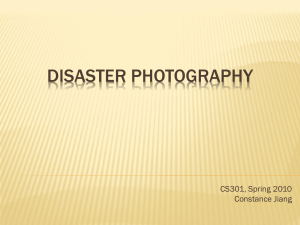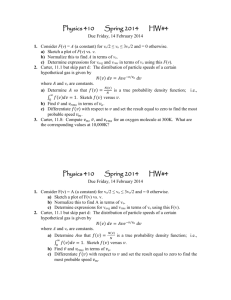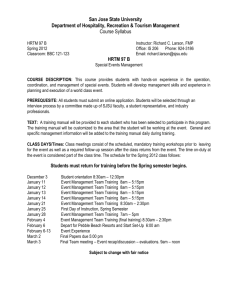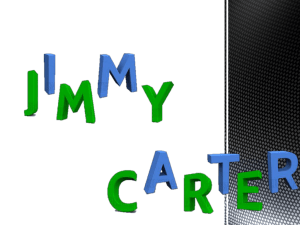Social Work 222 - Transcultural Multi
advertisement
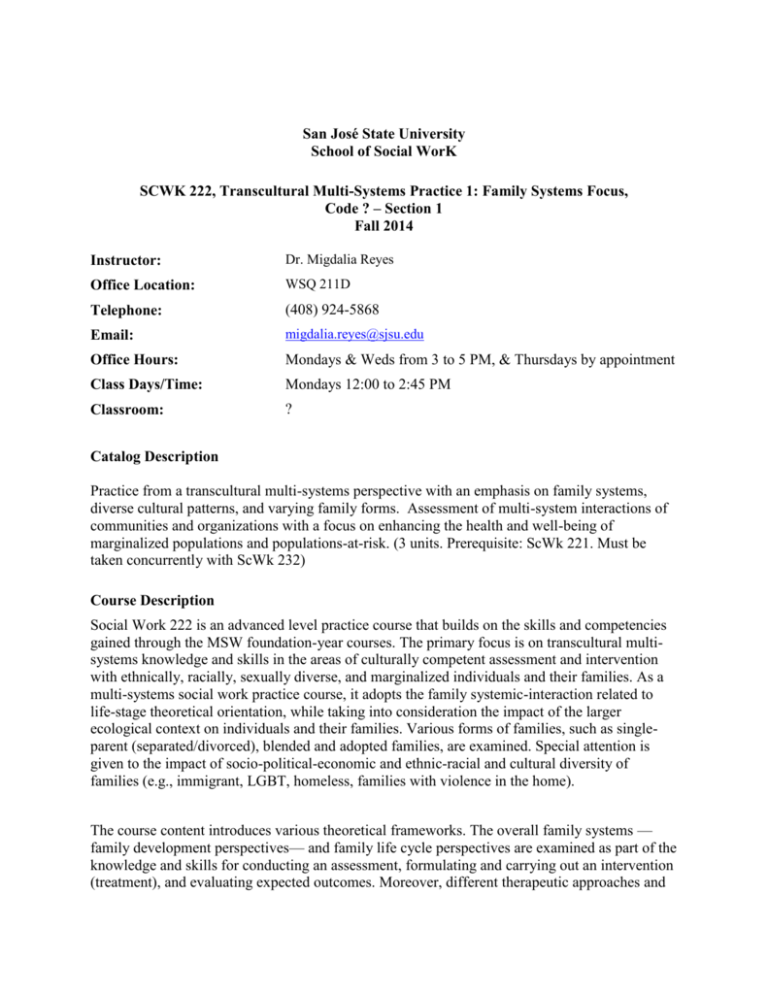
San José State University School of Social WorK SCWK 222, Transcultural Multi-Systems Practice 1: Family Systems Focus, Code ? – Section 1 Fall 2014 Instructor: Dr. Migdalia Reyes Office Location: WSQ 211D Telephone: (408) 924-5868 Email: migdalia.reyes@sjsu.edu Office Hours: Mondays & Weds from 3 to 5 PM, & Thursdays by appointment Class Days/Time: Mondays 12:00 to 2:45 PM Classroom: ? Catalog Description Practice from a transcultural multi-systems perspective with an emphasis on family systems, diverse cultural patterns, and varying family forms. Assessment of multi-system interactions of communities and organizations with a focus on enhancing the health and well-being of marginalized populations and populations-at-risk. (3 units. Prerequisite: ScWk 221. Must be taken concurrently with ScWk 232) Course Description Social Work 222 is an advanced level practice course that builds on the skills and competencies gained through the MSW foundation-year courses. The primary focus is on transcultural multisystems knowledge and skills in the areas of culturally competent assessment and intervention with ethnically, racially, sexually diverse, and marginalized individuals and their families. As a multi-systems social work practice course, it adopts the family systemic-interaction related to life-stage theoretical orientation, while taking into consideration the impact of the larger ecological context on individuals and their families. Various forms of families, such as singleparent (separated/divorced), blended and adopted families, are examined. Special attention is given to the impact of socio-political-economic and ethnic-racial and cultural diversity of families (e.g., immigrant, LGBT, homeless, families with violence in the home). The course content introduces various theoretical frameworks. The overall family systems — family development perspectives— and family life cycle perspectives are examined as part of the knowledge and skills for conducting an assessment, formulating and carrying out an intervention (treatment), and evaluating expected outcomes. Moreover, different therapeutic approaches and clinical modalities are examined and adopted within the context of the strengths-based model, and the need to advance human rights and promote social justice when delivering social work services to families. Competences The following Competencies/Program Objectives (PO) are realized through this course: PO 1. Demonstrate capacity to work effectively in the role of a professional social worker within the context of a field of practice. PO 2. Apply ethical principles, codes of ethics and professional social work values skillfully in practice and in resolving ethical conflicts. PO 3. Apply critical thinking skills using logic, scientific inquiry, and reasoned discernment in order to synthesize information, communicate professional judgments, and practice effectively in the context of specific fields of practice. PO 4. Consistently demonstrate ability to work effectively with diverse populations and apply the transcultural perspective in the context of a specific field of practice. PO 5. Apply multi-systems knowledge and skills to advocate with, and on behalf of, diverse and marginalized communities. PO 9. Apply a multi-systems and transcultural perspective in analyzing and responding to contexts that shape practice in specific social work fields. PO 10. Differentially select and apply effective engagement, assessment, intervention and evaluation skills in multi-systems practice with diverse populations. Course Practice Behaviors (PB) Student Learning Objectives (SLO) Upon completion of ScWk 222 students will be able to: 1. Exhibit practice effectiveness regarding building professional relationships between clients, colleagues, and institutions, and demonstrate awareness of potential biases, in order to build on the type of professional conduct that guides social work practice. PB: 1 (a, b, c, d, e) (Professional Social Work) 2. Apply with integrity the values, ethics, and legal mandates of the National Association of Social Workers Code of Ethics, in all phases of contacts with families, as well as demonstrate awareness of personal biases, and the capacity to identify, manage, and correct these. PB: 2 (a, b) (Ethics) 3. Display critical thinking skills, and effective oral and written communication in working with individuals and their families. PB: 3 (a, b, c) (Critical Thinking) 4. Demonstrate knowledge and skills at intra and intersystemic levels, by integrating a transcultural social work perspective, and strengths-based and empowerment approaches to practice. PB: 4 (a) (Diversity and Transcultural Perspective) 5. Demonstrate knowledge of family systems in the context of factors that due to historical, economic, political and social conditions, negatively impact families, and lead to oppression, marginalization, poverty, and discrimination. This knowledge will provide the foundation for promoting strategies that support social, economic and political justice in social work delivery of services to families. PB: 5 (b, c) (Social and Economic Justice). 6. Ability to seek and access information, scientific and technological resources, and emerging societal trends to provide relevant services at all levels of practice with families. PB: 9 (a) (Shape Practice) 7. Demonstrate knowledge and apply skills involving dynamic and interactive processes of engagement, assessment, intervention, and evaluation at multiple levels with individuals and families. PB: 10 (c-c) (Engagement and Assessment) Required Texts/Readings Textbook McGoldrick, M., Carter, B., & García-Preto. N. (2011). The expanded family life cycle: Individual, family, and social perspectives (4th ed.) Boston: Allyn and Bacon (1) Other Readings Becvar, D.S., & Becvar, R.J. (2009). Family therapy: A systemic integration (7th Edition). Boston: Allyn and Bacon. (2) Boyd-Franklin, N. & Bry, B.H. (2000). Reaching out in family therapy: Home-based, school, and community interventions. New York: The Guilford Press (2) American Psychiatric Association (2000). Diagnostic and statistical manual of mental disorders (4th ed. Text Revised). Washington, DC: Author Inc. (3) I did not order this textbook through the bookstore. I suggest that in order for you to save money (the price of the 2011- 4th edition is $146.80) you order the specific chapters through coursesmart.com, or purchase the 3rd edition online. If you buy the old edition, you need to be responsible for checking the reading topics and reconcile different page numbers that are assigned on the syllabus. Through coursesmart.com, you need to register with http://www.coursesmart.com/the-expanded-family-life-cycle-individual/monicamcgoldrick-betty-carter-nydia-garcia/dp/9780205747979. The etext is ISBN-10 0-205-74797-3 or ISBN-13 978-0-205-74797-9. The printed copy is very expensive, but if you want to purchase it, the ISBN is 10 0-205-74796-5 or 13 978-0-205-74796-2. (1) There is no need for you to purchase these books. However, if you are interested, they can do so through the Guilford Press, and Allyn and Bacon publication companies, online (e.g., Amazon), or from a student who took the course during prior years. (2) The DSMIV or 5 is expensive. I suggest you obtain it from your agency or MLKing Library. (3) Important Note: The assigned readings that do not appear in your textbook will be sent to you electronically by the instructor. These are marked as “e-copy” on the Course Outline. I use the roster to access your email address. Make sure it is listed correctly on your university contact information. Library Liaison For assistance in the library go to the King Library Reference Desk (2nd floor; 808-2100) and/or utilize the Social Work Research Guide available at http://libguides.sjsu.edu/scwk. The Social Work Library Liaison is: Teresa Slobuski, who may be reached by phone (408.808.2015) or email (Teresa.Slobuski@sjsu.edu). Classroom Protocol This course includes didactic lectures, interactive learning exercises, and seminar-style discussion. Please note in order to save resources the School of Social Work is moving toward the distribution of class syllabi and handouts via electronic means (e.g., email and Canvas). Students are expected to maintain professionalism; this includes preserving the confidentiality of clients/cases (discussed in class or written in assignments), and their professional peers (e.g., FFLs, FI, and fellow students). Professional development includes consultation with fellow students. This includes being respectful of opinions, perspectives and ideologies; refraining from disruptive behavior; and take the opportunity to use one another as a resource. I ask you to consult with me when you do not understand what is covered, open yourself to asking questions, and be engaged in your own learning process. Please communicate with me regarding any concerns about the course and your progress in it. I take very seriously the responsibility of grading your work and will always strive to be fair in my evaluations. Please know that I provide a lot of feedback and often will edit in the spirit of helping improve the quality of your work. If your work will result is less than a B-, I will on a one-time basis, offer you the option of rewriting/resubmitting the paper. This will help you practice writing that specific type of paper, as well as obtain a higher point grade. Note, however, that a rewrite does not qualify for the full assignment points (and typically might mean only obtaining 2 or 3 more points). My guidelines on contested grades are as follow: If you are unhappy with a grade, I require you to wait at least one day after receiving your work before contacting me to discuss the matter. During this time, I ask that you read and consider my comments carefully. I strongly recommend that you rewrite your paper or exam using the feedback and/or editing I provided in order to see how it may improve. However, note that a rewrite (when applicable) is your decision. I also ask that you set up an appointment with me, and come with a reasonable explanation as to why you believe the grade is inaccurate. I will take your thoughts seriously and will listen earnestly to each request and judge it on its merits. Dropping and Adding Students are responsible for understanding the policies and procedures about add/drops, academic renewal, etc. Refer to the current semester’s Catalog Policies section at http://info.sjsu.edu/static/catalog/policies.html. Add/drop deadlines can be found on the current academic calendar web page located at http://www.sjsu.edu/academic_programs/calendars/academic_calendar/. The Late Drop Policy is available at http://www.sjsu.edu/aars/policies/latedrops/policy/. Students should be aware of the current deadlines and penalties for dropping classes. Assignments and Grading Policy Your grade in this course will be based on your presentations, written work, tests and participation as follows: Assignment Points Mid-Term Exam Family Observation Paper Family Assessment & Treatment plan (group project) Group Presentation Participation Total 15 20 30 20 15 100 Course Student Learning Objective/Competency (SLO) PB: 1-3, 7 PB: 3, 4, 6, 7 PB: 2, 4, 5, 6, 7 PB: 4-6, 7 PB: 1-6, 7 Penalty for Late Work All assignments will be turned at the start of class by the due date. Assignments turned in after the due date could be subject to an automatic 5% deduction. Assignment 1 Mid-Term Exam 15 Points This is a take-home exam that presents the student with a number of questions related to what was covered in class and in the readings. Content includes areas of ethical standards of practice, transcultural social work, history of family practice, and content on assessment and intervention. The exam will emailed to you on 9/15 Due Date: 10/13 Assignment 2 Family Observation Paper 20 points Students will view a film (see suggested listing below) on their own that depicts various family types, structures, situations, dynamics, etc. Although you do not have to cite the literature for this paper, it is highly recommended that you complete the McGoldrick, M., & Carter, B. (2011). Coaching at various stages of the life-cycle. (Chapter 27, pp. 412-428) reading to guide your understanding of some of the concepts used in this assignment. A) Reflect on, and write observations about areas highlighted in the film that relate to what has been discussed in class and in the McGoldrick readings. Include a thorough and thoughtful description of one presenting problem and background of that problem; an in-depth analysis of the family’s functioning by focusing on aspects that you view as essential to the presenting problem; and address the following concepts: 1) Family system roles 2) Characteristics of the various subsystems 3) Cultural elements that impact the family 4) Rules and traditions (could include also cultural traditions) 5) Family stress, dysfunction, and risk factors 6) Boundary issues (e.g., clear, rigid, and/or diffuse), and relational distance issues (e. g., disengaged-enmeshed continuum), projections, emotional cutoffs, alliances, coalitions, conflicts, triangles, collusive relationships 7) Hierarchies of power 8) Family life cycle and individual developmental issues 9) Major transitions 10) Strengths of members of the family Note: You should use italic to highlight these concepts on your paper. Note that not all of them may apply, however you should show evidence of use of most. (10 Points) B) Pretend you are working with the family observed in the movie, and taking into account cultural, linguistic (if applicable), social, economic and political factors related to the reality of the family observed, use the School of Social Work’s transcultural social work model in order to demonstrate critical thinking skills in your analysis. Make sure you address your role as a social worker (e.g., your level of awareness and consciousness) if working with the family you observed in the movie. (10 points) Suggested movies: Adrift (2008) Biutiful (2010) My Life as a Dog (1985) Nina’s Tragedies (2005) Only Human (2004) Pan’s Labyrinth – El Laberinto de Fauno (2006) Precious (2009) Southern Comfort (2001) documentary The Color Purple (1985) The Namesake (2006) The Scent of Green Papaya (1994) The Separation (2011) Tokyo Sonata (2009) Note: Other suggested films on families are welcomed. If you would like to choose a film not listed, please speak with me for approval. I recommend that you look up these films online and read about them before you make your selection. Some are foreign films and have subtitles, and some are non-traditional, such in the case of Pan’s Labyrinth, which is a fantasy film, but shows very important elements related to family dynamics, and challenges to a child. Only Human is a comedy, but there is also important information that can be drawn from due to the JewishPalestinian conflict that takes place among the family. Most of these films you can access through Netflix. Length of paper: 4 pages (not to exceed 5 pages) double-spaced 11 pt. font. No cover page required. You can print in two-sided. Due Date: 11/3 Assignment 3 and 4 Family Assessment & Treatment-Intervention Plan (FATIP), and Class Presentation Group Project 30 points for FATIP, and 20 points for class presentation This assignment is two-fold. It includes: (1) writing a paper based on completing a case formulation assessment, proposing a treatment-intervention plan and family therapy theory approach or treatment modality; and (2) making a group class presentation in the format of a case consultation social work team meeting. During Session II, 9/3, the members of the class will be divided into working groups of 4 students. Group-member selection will be based on a chosen family therapy theory approach or treatment modality perspective (see attached guidelines for list). The members of your group will work collaboratively, analyzing the chosen family case, carrying out the (mock) assessment and proposing a treatment-intervention plan, which includes explaining the application of a family treatment theory approach and/or treatment modality. In the later part of the class sessions, the groups will have a portion of class time to work on the assignment. The group presentations will be scheduled for 30 minutes and will take place on 11/17 & 12/1. This two-part assignment is a group grade and every member is expected to make the same type of time and work commitment. The assignment is designed to help students integrate lecture/readings and practice experiences. See attached detailed guidelines for completing assignment and breakdown for points. Due Date of Paper: due 12/1 (bring a self-addressed and stamped envelope of one of the members of your group for return) Class Participation: 15 Points Professional development includes class attendance since it is the main form for acquiring new knowledge and skills, and consulting with class members (especially the members of the group assignment). As part of class participation students are expected to critically analyze information that is presented/discussed, bring examples and applications of the concepts being covered, be prepared to discuss readings, and provide additional insights on issues from their own special knowledge, professional expertise and internship/social service agency experience. It is expected that the student assume responsibility for her/his learning, and the quality and success of this course. With this in mind, please note that cell phones and laptop computers can only be used for class-related activities. Please let me know if you are “on call” and required to check your cell calls. The use of laptops and cell phones (including texting) for personal purposes, chronic tardiness, absence from the group assignment meetings, and disruptive behavior and/or inattentiveness will be reflected in the participation grade. To minimize class disruptions please arrive on time. Class attendance will be usually taken and recorded during the first part of class sessions. Students should notify the instructor in advance via email if not able to attend class or if there is a need to leave class early. Also, you must contact your team group if not in class during sessions when groups will meet to discuss the Family Assessment & TreatmentIntervention Plan assignment. APA Format and Writing Requirements: The Publication Manual of the American Psychological Association (APA) 6th edition, is the style manual adopted by the Masters in Social Work Program. All papers must follow current APA format guidelines with the following exceptions: the use of running heads is not necessary. All papers must use standard, 11 or 12-point fonts (e.g., Times Roman) and be free of typographical, formatting, spelling, and content errors, as the quality of the writing will be evaluated as part of the grade for all written assignments. All papers should be written in standard/formal English; avoid slang and refrain from overuse of jargon. It is strongly recommended that you make use of WORD tools for edit your work (spell check and grammar check). Be sure to carefully review and edit all drafts prior to submission. All ideas, quotes, and information taken or derived from other sources must be appropriately cited and referenced in accordance with APA rules. Make sure to add a reference if using a website. See School of Social Work Writing Policy for more information. All papers, including exams and the group exercise papers will be graded according to the following criteria: 1) Addressing the topic that is relevant to the assignment. 2) Clarity and flow of written discussion. 3) Answering questions completely and thoughtfully. 4) Demonstrate understanding and using critical analysis. 5) Obvious effort and attention to the material required for the assignment. 6) Organization. 7) Appropriate citing of sources used (APA). When adding a review of the literature (a piece of information from an author other than yourself), make sure to separate what you are writing about your own experience (e.g., with a case), and what an author writes (whether using the author’s quote or paraphrasing what s/he wrote). Submitting Papers It is important that papers are submitted on time. Please note that I am unable to accept papers online. If you are not in class when an assignment is due, you must bring it directly to my office, or give it to a front-office staff person at the School of Social Work’s main office (WSQ Hall Suite 215) by 5:00 PM. The date of receipt must be stamped on the front page by the staff person. It is your responsibility to confirm that I have received your paper. Grading The grading and evaluation distribution for the class is outlined below. Percentage. 97-100%. 93-96%. 90-92%. 87-89%. 83-86%. 80-82%. 77-79%. 73-76%. 70-72%. 67-69%. 63-66%. 60-62%. Below 60%. Grade. A+ A. AB+ B. BC+ C. CD+ D. DF.. University Policies Academic integrity Your commitment as a student to learning is evidenced by your enrollment at San Jose State University. The University’s Academic Integrity policy, located at http://www.sjsu.edu/senate/S07-2.htm, requires you to be honest in all your academic course work. Faculty members are required to report all infractions to the office of Student Conduct and Ethical Development. The Student Conduct and Ethical Development website is available at http://www.sa.sjsu.edu/judicial_affairs/index.html. Instances of academic dishonesty will not be tolerated. Cheating on exams or plagiarism (presenting the work of another as your own, or the use of another person’s ideas without giving proper credit) will result in a failing grade and sanctions by the University. For this class, all assignments are to be completed by the individual student unless otherwise specified. If you would like to include your assignment or any material you have submitted, or plan to submit for another class, please note that SJSU’s Academic Policy S07-2 requires approval of instructors. Campus Policy in Compliance with the American Disabilities Act If you need course adaptations or accommodations because of a disability, or if you need to make special arrangements in case the building must be evacuated, please make an appointment with me as soon as possible, or see me during office hours. Presidential Directive 97-03 requires that students with disabilities requesting accommodations must register with the Disability Resource Center (DRC) at http://www.drc.sjsu.edu/ to establish a record of their disability. School of Social Work Policies School of Social Work Writing Policy The Instructor will return selected assignments (as specified elsewhere in the syllabus) ungraded if at least five unique errors are found in grammar, punctuation, sentence structure, spelling, typos, APA style, or other basic writing errors. Late penalty points may apply, as specified in the syllabus. A unique error is an error that will be counted 1 time. For example, if a possessive apostrophe is left off of a word 5 times in a paper, it will be counted as 1 error (i.e. a possessive apostrophe error). It is the student’s responsibility to make corrections throughout the paper and ensure there are no additional instances of the error in the paper before re-submitting the paper and submitting next assignments. University Resources Student Technology Resources Computer labs for student use are available in the Academic Success Center located on the 1st floor of Clark Hall and on the 2nd floor of the Student Union. Additional computer labs may be available in your department/college. Computers are also available in the Martin Luther King Library. A wide variety of audio-visual equipment is available for student checkout from Media Services located in IRC 112. These items include digital and VHS camcorders, VHS and Beta video players, 16 mm, slide, overhead, DVD, CD, and audiotape players, sound systems, wireless microphones, projection screens and monitors. Learning Assistance Resource Center The Learning Assistance Resource Center (LARC) is located in Room 600 in the Student Services Center. It is designed to assist students in the development of their full academic potential and to inspire them to become independent learners. The Center's tutors are trained and nationally certified by the College Reading and Learning Association (CRLA). They provide content-based tutoring in many lower division courses (some upper division) as well as writing and study skills assistance. Small group, individual, and drop-in tutoring are available. Please visit the LARC website for more information at http://www.sjsu.edu/larc/. SJSU Writing Center The SJSU Writing Center is located in Room 126 in Clark Hall. It is staffed by professional instructors and upper-division or graduate-level writing specialists from each of the seven SJSU colleges. Our writing specialists have met a rigorous GPA requirement, and they are well trained to assist all students at all levels within all disciplines to become better writers. The Writing Center website is located at http://www.sjsu.edu/writingcenter/about/staff/. Peer Mentor Center (Optional) The Peer Mentor Center is located on the 1st floor of Clark Hall in the Academic Success Center. The Peer Mentor Center is staffed with Peer Mentors who excel in helping students manage university life, tackling problems that range from academic challenges to interpersonal struggles. On the road to graduation, Peer Mentors are navigators, offering “roadside assistance” to peers who feel a bit lost or simply need help mapping out the locations of campus resources. Peer Mentor services are free and available on a drop –in basis, no reservation required. The Peer Mentor Center website is located at http://www.sjsu.edu/muse/peermentor/ TOPIC OUTLINE AND ASSIGNMENTS Session Date Topics, Readings, Assignments, Deadlines SLO 1 8/25 Topics: Introduction of course content What is family therapy? Professionalism in social work and PB:1-4 the code of ethics. 2 9/1 Topic: The Family Life Cycle: A general understanding of the family life-cycle theory to contemporary family structures. Required Reading McGoldrick, M., Carter, B., & García-Preto. N. (2011). Overview: The life cycle in its changing context: Individuals, families and social perspectives. Chapter 1, pp. 1-19. Recommended Reading McGoldrick, M., Carter, B., & García-Preto. N. (2011). Self in context: Human development and the individual life cycle in systemic perspective. Chapter 2, pp. 20-41. The Family Assessment & Treatment-Intervention Plan PB: 3, 4, 6 groups will be formed 3 9/8 Topic: Transcultural social work; Multi-systems social work practice; practice with culturally diverse and marginalized, oppressed, and disenfranchised families. PB: 4, 5, 6 Movie viewing: Raising Victor Vargas (2003) Required Readings Boyd-Franklin, N. & Bry, B.H. (2000). Cultural, racial and socioeconomic issues. Reaching out in family therapy: Home-based, school, and community interventions (pp. 1133). New York: The Guilford Press. (e-copy) 4 9/15 Topic: Families at-risk (family dysfunction) and family resilience (strengths-based model); systemic interactions related to health, and mental health challenges, including parent, and child emotional and behavioral problems. PB: 2, 6, 7 Required Reading Berman, E, & Heru, A. (2011). Psychiatric illness and the life cycle. In M. McGoldrick, B. Carter, & N. García-Preto. Chapter 26, pp. 398-411. Mid-Term Exam will be sent out 6 9/22 Topic: The bio-psycho-social assessment as tool for working with families; use of the DSMIV or 5, genogram, and ecomap. PB: 2, 6, 7 Assignment: Bring to class a genogram of a family (it can be of a client family system you are working with, or of your own family). A sample of the genogram is found in the McGoldrick, M., Carter, B., & García-Preto. N. (2011): Family chronology or time line (p. 454-455). Required Reading McGoldrick, M., Carter, B., & García-Preto. N. (2011). A multicontextual life-cycle framework for clinical assessment. Appendix, pp. 447-455. Recommended Reading Boyd-Franklin, N. & Bry, B.H. (2000). A multisystems case example. Reaching out in family therapy: Home-based, school, and community interventions (pp. 163-177). New York: The Guilford Press. (e-copy). 7 9/29 Topic: Theories and approaches to family practice, and interventions; discussion and utilization of family therapy interventions with an emphasis on behavioral/cognitive PB: 2, 6, 7 approaches. Required Readings McGoldrick, M., & Carter, B. (2011). Coaching at various stages of the life-cycle. In M. McGoldrick, B. Carter, & N. García-Preto. Chapter 27, pp. 412-428. Becvar, D.S., & Becvar, R.J. (2009). Behavioral/cognitive approaches. Family therapy: A systemic integration (pp. 227248). Boston: Allyn and Bacon. (e-copy) 8 10/6 Topic: Family intervention from a transcultural multisystems practice (part I): Discussion and utilization of techniques for delivering services to families utilizing culturally competent methodologies. The use of the culturegram. PB: 3-5, 7 Assignment: Bring a culturegram to class (it could be of a client family system, or your own family). It may include the following: Reasons for relocation Legal status Time in community Language spoken at home and in the community Health beliefs Crisis events Holidays and special events Contact with cultural and religious institutions Values about education and work Values about family - structure, power, myths, and rules Required Reading Moore-Hines, P. (2011). The life-cycle of African American families living in poverty. In M. McGoldrick, B. Carter, & N. García-Preto. Chapter 6, pp. 89-102. Recommended Reading Kliman, J. (2011). Social Class and the life-cycle. In M. McGoldrick, B. Carter, & N. García-Preto. Chapter 5, pp. 75-88. 9 10/13 Topic: Family intervention from a transcultural multisystems practice (part II): Discussion and utilization of techniques for delivering services from a feminist perspective. Required Reading PB: 1, 2, 4, 5, 7 McGoldrick, M. (2011). Women and the family life-cycle. In M. McGoldrick, B. Carter, & N. García-Preto. Chapter 3, pp. 42-58. Recommended Reading Mock, M. R. (2011). Men and the family life-cycle: Diversity and complexity. In M. McGoldrick, B. Carter, & N. García-Preto. Chapter 4, pp. 59-74. Mid-Term Exam Due 10/20 Topic: Family intervention from a transcultural multisystems practice (part III): Discussion and utilization of techniques for delivering services to lesbian, gay, bisexual and transgender families. Required Reading PB: 1, 4, 5, 7 Ashton, D. (2011). Lesbian, gay, bisexual and transgender individuals and the family life-cycle. In M. McGoldrick, B. Carter, & N. García-Preto. Chapter 8, pp. 115-132. 10 10/27 Topic: Violence in the home, child abuse, ritual abuse, and intergenerational violence. Alcohol and other drugs; the challenges of co-dependency, and cultural considerations of family rescuing. Required Readings 1, 4, 5, 7 McGoldrick, M. & Ross, M.A. (2011). Violence and the family life-cycle. In M. McGoldrick, B. Carter, & N. GarcíaPreto. Chapter 25, pp. 384-397. Laszloffy, T.A. (2011). Alcohol problems and the family life-cycle. In M. McGoldrick, B. Carter, & N. García-Preto. Chapter 24, pp. 368-383. 11 11/3 Spiritual notions in service delivery of families. Groups will meet to work on the Family Assessment & Treatment-Intervention Plan paper and prepare for presentation. PB: 4, 5, 7 Required Reading Petry, S. (2011). Spirituality and the family life-cycle. In M. McGoldrick, B. Carter, & N. García-Preto. Chapter 9, pp. 133-148. Family Observation Paper Due 12 11/10 Topic: Grief and loss; challenges resulting from aging families, and death and dying. Groups will meet to work on the Family Assessment & Treatment-Intervention Plan paper and prepare for PB: 4, 5, 7 presentation. 13 11/17 Family Assessment & Treatment-Intervention Plan Group Presentations 14 11/24 Groups will meet to work on the Family Assessment & Treatment-Intervention Plan paper due next week. 15 12/1 Family Assessment & Treatment-Intervention Plan Group Presentations Family Assessment & Treatment-Intervention Plan paper due (bring a self-addressed and stamped envelope of one of the members of your group for return) 16 12/8 Wrap-up PB: 7 PB: 1-4, 6, 7 Family Assessment & Treatment-Intervention Plan (FATIP) Group Assignment Guidelines (30 Points - Group Grade) I- Selection of the Group Four or five members will be selected for each group. The number of members is based on course enrollment. The selection of members will be determined by the chosen theory approach or treatment modality perspective listed below (one group per approach). a) Feminist Models (or gender-sensitive including working with non-passing transgender and other gender non-conforming clients) b) Natural Systems Theory Approach c) Experiential Approach d) Structural Approach e) Strategic/Systemic Approach and the Milan Influence f) Postmodern Approach g) Internal Family Systems Model h) The Gottman Couples Counseling Approach This assignment relies on the strengths of your group to formulate a case with the use of an assessment and a proposed intervention on a family client system. This includes: problem identification, assessment, and evaluation (as well as termination, if applicable). The family chosen can be selected from a case from one of the members of the group (either from her/his internship or the social service agency where employed), or created as a case-vignette by the group. Communication and democratic collaboration between group members is key to the success of this project. Your group will work as a task group to achieve the completion of this assignment. This will require teamwork, and collective (collegial) decision-making. I will be available for group consultation. When meeting in class, your group may request in-class consultation, or can make an appointment during my office hours (see syllabus for office hours). Guidelines for the FATIP project and writing the group paper A) Provide a one-page summary of the case based on a bio-psycho-social assessment of your chosen family (not to exceed one page). Add a DSMIV diagnosis if there is one. Define the problem or challenge in a clear way by providing background information. Although you do not have to cite this source in the text of your write up of the case, the required readings for this section are: (1) the McGoldrick, M., Carter, B., & García-Preto. N. (2011). A multicontextual life-cycle framework for clinical assessment (pp. 447-455), and (2) the Boyd-Franklin, N. & Bry, B.H. (2000): A multisystems case example (pp. 163-177) since they serve as a model and provide examples to help your group complete the assessment of your chosen family. Make sure to include all of the relevant background information that a social worker, which is not familiarized with the case, will need in order to follow the case and understand your group’s proposed intervention. This includes: the problem/challenge (e.g., substance abuse, marital infidelity, domestic violence, adolescent delinquency, gang involvement, etc.), a diagnosis (if there is one), diverse family forms, risk factors, and implications of family dynamics. Also, weave in content related to the transcultural perspective. Attach a genogram and, if applicable, add a culturegram (both as an appendix to the paper). The culturegram includes the following: Reasons for relocation. Legal status Time in community Language spoken at home and in the community Health beliefs Crisis events Holidays and special events Contact with cultural and religious institutions Values about education and work Values about family - structure, power, myths, and rules (7 points) B) Define the type of family you are working with, and discuss and illustrate the family lifecycle theory in relation to your chosen family’s experience. Make sure to show evidence of use of the literature by weaving salient concepts of the reading with illustrations from the family. Of particular importance is McGoldrick, M., Carter, B., & García-Preto. N. (2011): Overview: The life cycle in its changing context: Individuals, families and social perspectives (pp. 1-19). (5 points) C) Propose a family social work intervention (treatment plan) based on your assessment and DSMIV or 5 diagnosis (if there is one). Some of the information required includes: goals and objectives, recommended counseling or therapy sessions (e.g., number of sessions), collateral information being sought, advocacy skills required, and proposed case management activities (e.g., wrap around services at: name agency ___). Attach an ecomap as an appendix. Make sure to include information on expected outcomes that suggest the members of your group and the family are meeting the goals and objectives set out. (10 points) D) You will need to research and describe in detail the topic of the therapy approach (theory) or treatment modality perspective your group has signed up for. Use the literature (must show evidence of use) to describe the chosen approach, and be clear when illustrating its application to your group’s family case (e.g., provide a couple of examples on how the family therapy approach, or the treatment modality is used). The Becvar, D.S., & Becvar, R.J. (2009) Family therapy: A systemic integration. Boston: Allyn and Bacon, is an excellent source for literature on some of the approaches. I will make the textbook available to the groups. (7 points) E) Suggest how you are going to evaluate the outcomes (success) of your intervention (1 points). Note: Show appropriate use of APA skills (see APA guideline on syllabus), and graduate level & professional writing (See School of Social Work Writing Policy) II. Writing the Group Paper The members of the group must together write and submit a 6-page paper (excluding cover page, reference page and appendix). It is not to exceed 7 pages. The paper must respond to the questions presented above, and those that emerge during the working-groups’ progress. It is up to the group members to decide how to divide up the work for writing the paper. However, remember that this is a group grade and every member is expected to make the same type of time and work commitment. I suggest that you meet as a group to write the paper, and limit the use of email to complete it (I have always received negative feedback from students about the use of email as the sole method for writing a group paper because one or two students end up with the bulk of the writing, and resentment is generated). On November 26 we will not meet in class and the session will be reserved for your group to write the paper and prepare for the presentation. I will be available for consultation by appointment. III. Class Group Presentation (20 points - Group grade) It is up to the group members to decide how to organize the presentation. Of course the family’s challenge or problem, treatment-intervention plan, and family therapy approach or treatment modality perspective must be part of the presentation. The main format is that of a case consultation to a team of social workers. However, you can be creative by using a short simulated session (a role-play scenario with your mock family that illustrates techniques and strategies derived from your group’s chosen therapy practice approach). Some ideas to consider while putting your presentation together are as follow: a. What do your peers (social work colleagues) need to know about your group’s chosen family, the assessment information, your proposed intervention plan, and expected outcomes? b. What do your colleagues need to know about your group’s chosen family therapy approach or treatment modality perspective? Show illustrations of its application. c. What resources are necessary to deliver effective services to the family? d. How will the proposed intervention benefit the family? e. What are some of the challenges that this case pose for your team (e.g., countertransference, immigration status of family), and what do you suggest be done to overcome these? f. How will the intervention be supported and sustained? g. How is the team going to evaluate the outcomes and success of the intervention? Because this is a group grade, every member needs to participate in the presentation. Those members, who are uncomfortable with public speaking, need to be supported through coaching and mentoring by the members of the group. Make sure to provide the students (it could be via email to save paper) with a brief information ‘hand out’ related to the topic. Also, please email me a copy of the Power-Point transparencies. Presentation Grading Matrix for Group Presentation Content Information related to the topic, assessment and intervention proposal, and family therapy theory approaches or treatment modality perspective. (10 points) Organization, flow, professional delivery and expression, including appropriate interaction with other presenters and professional projection toward audience. This includes the use of a short simulation activity (e.g., role play). (5 points) Creativity, clarity, good use of time, and appropriateness of information displays (e.g., Visual Aids, handouts). (5 points) Dates of Family Assessment & Treatment Plan Group Presentations: 11/17 & 12/1
